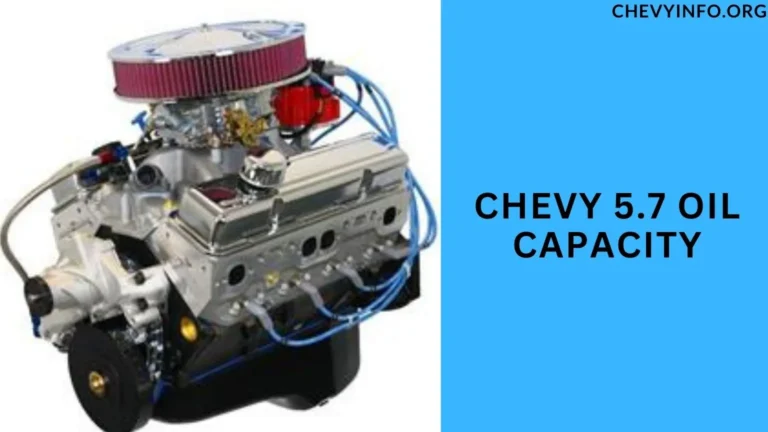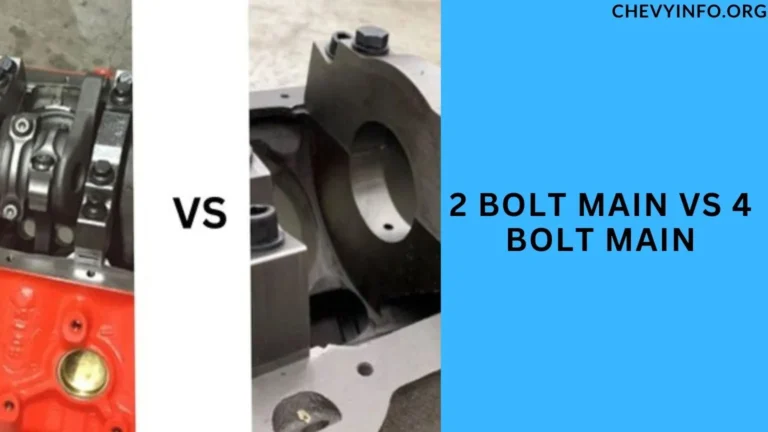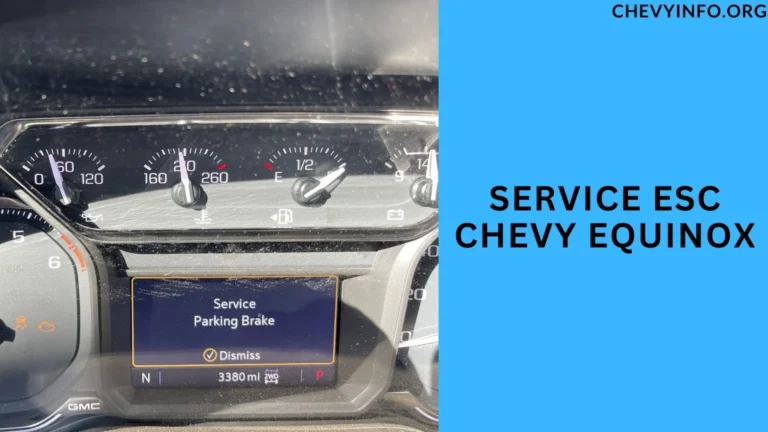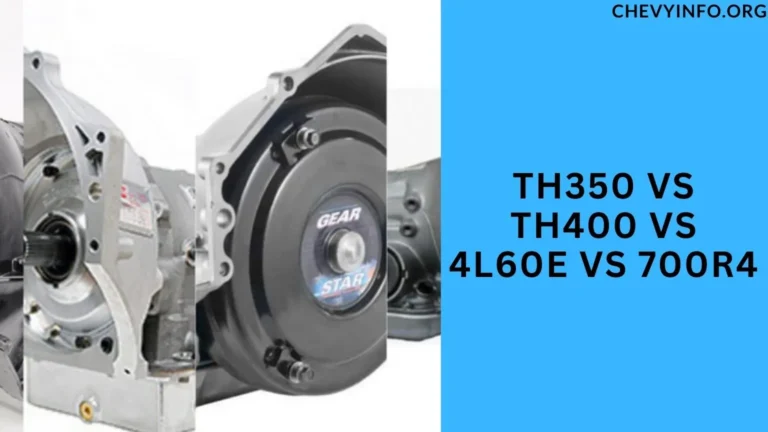LB7 VS LBZ VS LLY (Comparison Between) of 2024
Diesel engines have long been the backbone of heavy-duty vehicles, offering robust performance and reliability.
Among the popular choices in the diesel engine lineup are the LB7 VS LBZ VS LLY engines, each with its unique features and characteristics.
In this article, we’ll delve into a detailed comparison of these engines, covering everything from performance and durability to cost considerations and environmental impact.
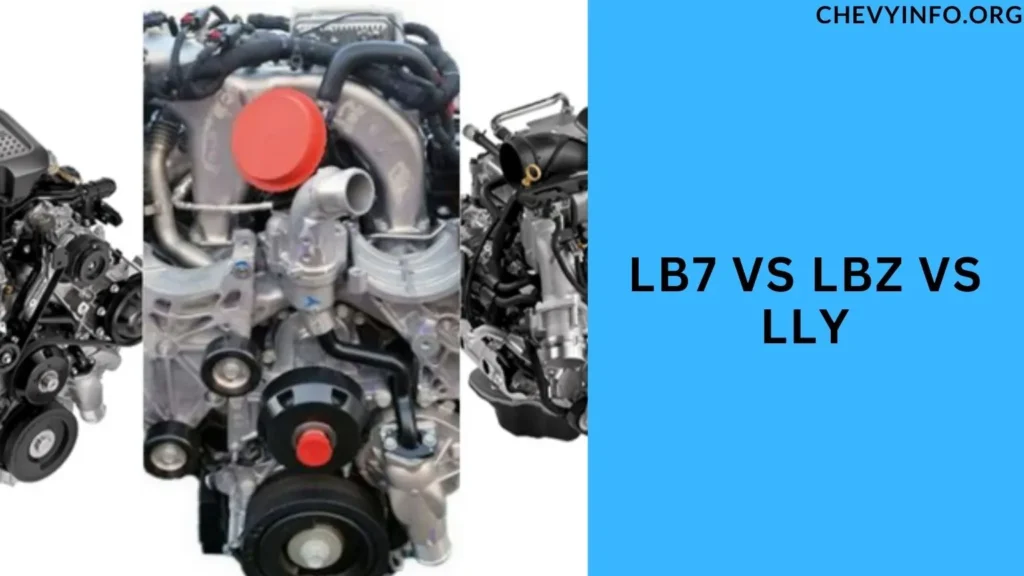
Introduction to LB7, LBZ, and LLY Engines
The LB7, LBZ, and LLY engines are all part of General Motors’ Duramax family of diesel engines.
These engines are commonly found in heavy-duty trucks, such as the Chevrolet Silverado and GMC Sierra.
Each engine variant has undergone iterations and improvements over the years, catering to different needs and preferences of truck owners.
Key Features of LB7 Engine
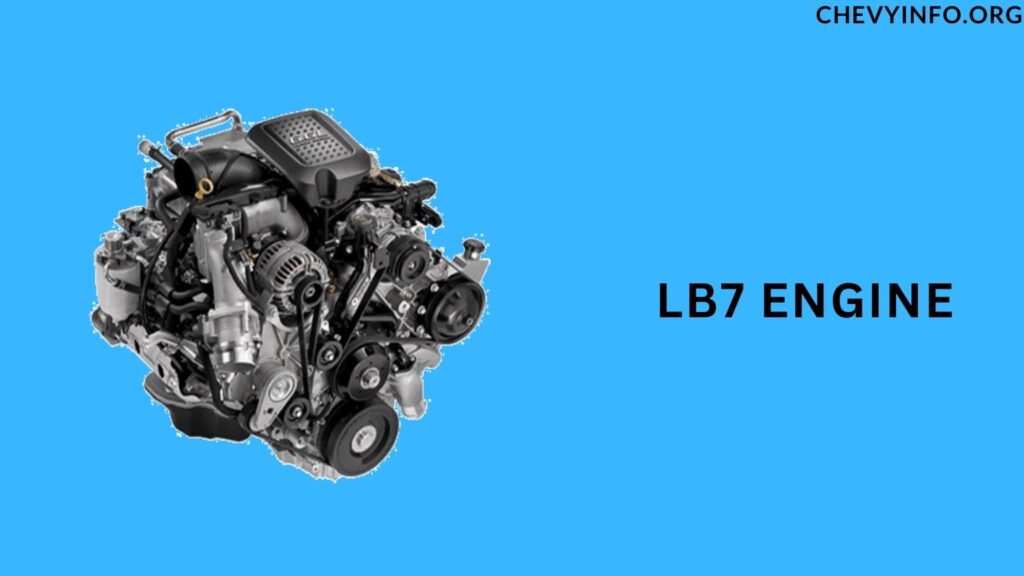
The LB7 engine was introduced in 2001 and marked a significant advancement in diesel engine technology. Key features of the LB7 engine include:
- Power Output: Produces around 300 horsepower and 520 lb-ft of torque.
- Injector Design: Utilizes a hydraulically actuated electronic unit injector system for precise fuel delivery.
- Durability: Known for its robust construction and reliability under heavy loads.
- Fuel Efficiency: Offers decent fuel economy for its class.
- Aftermarket Support: A wide range of aftermarket upgrades available for performance enhancements.
Key Features of LBZ Engine
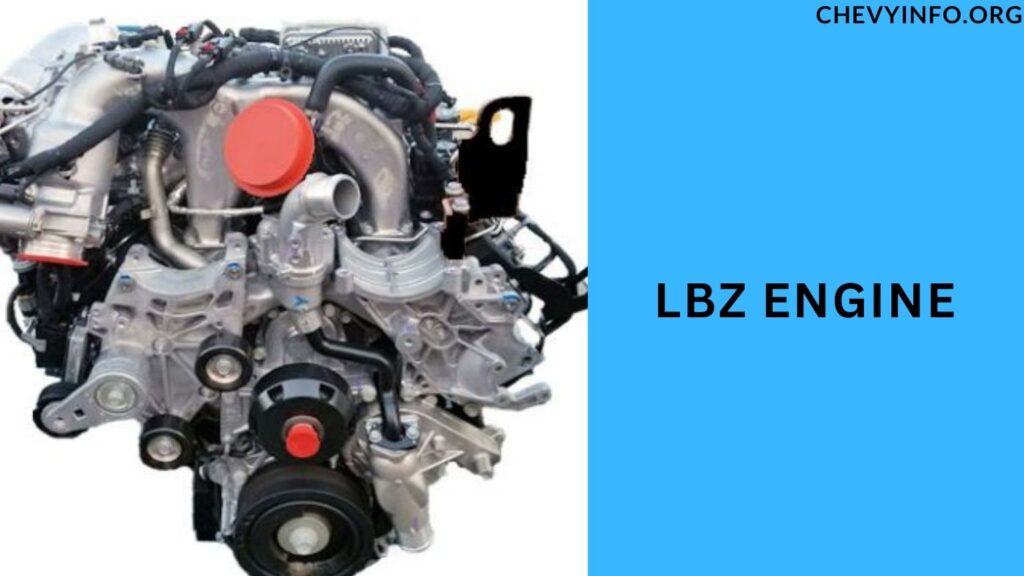
The LBZ engine succeeded the LB7 and brought several improvements to the table. Key features of the LBZ engine include:
- Power Output: Enhanced power delivery with approximately 360 horsepower and 650 lb-ft of torque.
- Emissions Compliance: Meets stringent emissions standards while maintaining performance.
- Improved Cooling: Upgraded cooling system for better thermal management.
- Durability: Retains the durability reputation of its predecessor.
- Towing Capacity: Suitable for heavy towing applications.
Key Features of LLY Engine

The LLY engine is another iteration in the Duramax lineup, known for its balance of performance and efficiency. Key features of the LLY engine include:
- Power Output: Generates around 310 horsepower and 605 lb-ft of torque.
- Variable Geometry Turbocharger (VGT): Improved turbocharger design for optimal power delivery across the RPM range.
- Emissions Compliance: Adheres to emissions regulations without compromising performance.
- Fuel Economy: Offers competitive fuel efficiency for a diesel engine.
- Reliability: Generally reliable with proper maintenance.
Performance Comparison Between LB7 VS LBZ VS LLY
When it comes to performance, each engine variant has its strengths. The LB7 engine is praised for its durability and torque delivery, making it a preferred choice for heavy-duty applications.
On the other hand, the LBZ engine shines in power output and towing capacity, appealing to users with demanding towing needs.
The LLY engine strikes a balance between power and fuel efficiency, suitable for everyday driving and light towing.
Durability and Reliability Comparison
Durability is a crucial factor in diesel engines, especially for vehicles used in rugged environments or heavy loads.
Both the LB7 and LBZ engines are renowned for their durability, with solid construction and reliable components. The LLY engine also offers respectable durability, provided regular maintenance is performed.
Fuel Efficiency Differences
Fuel efficiency is an important consideration for diesel engine owners, given the fluctuating fuel prices.
The LLY engine tends to be more fuel-efficient compared to the LB7 and LBZ engines, thanks to its improved turbocharger design and electronic controls.
Cost Considerations
The cost of ownership includes not just the initial purchase but also maintenance and potential repairs.
The LB7 engine Price ($9000 to $15000), being an older model, may have lower upfront costs but could require more maintenance over time.
The LBZ price (3000 to $14000) and LLY engine Price ($15k), being newer models, may have higher initial costs but could offer better long-term reliability and efficiency.
Aftermarket Support and Upgradability
One of the advantages of popular diesel engines like the LB7, LBZ, and LLY is the extensive aftermarket support.
Owners can choose from a wide range of upgrades, such as performance tuners, exhaust systems, and turbochargers, to enhance their vehicle’s capabilities.
Environmental Impact
In terms of emissions and environmental impact, newer engine models like the LBZ and LLY engines are designed to meet stringent emissions standards.
However, older models like the LB7 may require emissions modifications to comply with current regulations.
User Reviews and Experiences
User feedback plays a crucial role in understanding the real-world performance and reliability of these engines.
Reading user reviews and experiences can provide valuable insights into common issues, maintenance requirements, and overall satisfaction levels.
Common Issues and Maintenance
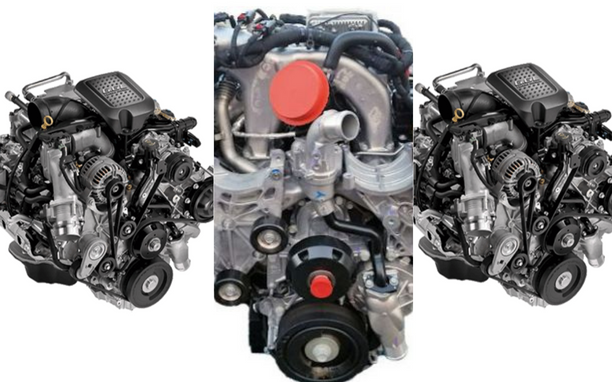
Diesel engines like the LB7, LBZ, and LLY, while robust and durable, can encounter specific issues over time. Proper maintenance is key to minimizing these issues and ensuring optimal performance.
Here are some common problems and maintenance tips for these engines:
Fuel System Problems
Issue: One common issue with diesel engines is fuel system problems, including injector issues, fuel pump failures, and fuel filter clogs.
Maintenance Tip: Regularly inspect and replace fuel filters as recommended by the manufacturer. Use high-quality diesel fuel and additives to prevent injector deposits and maintain fuel system cleanliness.
Turbocharger Issues
Issue: Turbocharger problems such as turbo lag, wastegate issues, or compressor/turbine damage can affect engine performance.
Maintenance Tip: Follow proper warm-up and cooldown procedures to prevent turbocharger damage. Monitor boost levels and address any abnormal noises or performance issues promptly.
EGR (Exhaust Gas Recirculation) System Failures
Issue: EGR system failures can lead to reduced engine performance, increased emissions, and potential engine damage.
Maintenance Tip: Keep the EGR system clean and free from carbon buildup. Regularly inspect EGR components and replace them if necessary to maintain proper exhaust gas recirculation.
Glow Plug Problems
Issue: Glow plug failures can cause difficulty starting the engine, especially in cold weather conditions.
Maintenance Tip: Test glow plugs regularly and replace any faulty ones. Use high-quality glow plugs rated for your engine’s specifications.
Cooling System Issues
Issue: Cooling system problems like coolant leaks, radiator issues, or thermostat failures can lead to engine overheating and damage.
Maintenance Tip: Inspect the cooling system regularly for leaks, corrosion, or coolant level changes. Replace worn-out hoses, clamps, and coolant as needed. Maintain proper coolant levels and ensure the cooling system is free from debris.
Transmission and Drivetrain Maintenance
Issue: Transmission and drivetrain issues, such as slipping gears, rough shifting, or differential problems, can impact overall vehicle performance.
Maintenance Tip: Follow the manufacturer’s recommended transmission service intervals. Check transmission fluid levels and condition regularly. Inspect drivetrain components for wear and replace worn-out parts promptly.
Electrical System Concerns
Issue: Electrical system failures, including battery issues, alternator problems, or wiring faults, can cause starting difficulties and electrical malfunctions.
Maintenance Tip: Test the battery, alternator, and starter regularly. Clean and inspect battery terminals for corrosion. Address any electrical system faults or warning lights promptly to prevent further damage.
Exhaust System Maintenance
Issue: Exhaust system issues such as leaks, exhaust manifold cracks, or DPF (Diesel Particulate Filter) problems can affect emissions compliance and engine performance.
Maintenance Tip: Inspect the exhaust system for leaks, damage, or excessive soot buildup. Replace worn-out components and address exhaust leaks promptly. Follow proper DPF maintenance procedures, including regeneration cycles as needed.
Choosing the Right Engine for Your Needs
The choice between LB7, LBZ, and LLY engines ultimately depends on your specific needs and preferences. Consider factors such as power requirements, towing capacity, fuel efficiency, and budget constraints when making your decision.
Future Trends in Diesel Engine Technology
Looking ahead, diesel engine technology continues to evolve, with advancements in fuel efficiency, emissions control, and performance.
Future diesel engines may incorporate hybrid technology, improved electronic controls, and alternative fuel compatibility to meet evolving market demands and environmental standards.
People also ask
What is the difference between LBZ LB7 and lly?
The main differences between LBZ, LB7, and LLY engines lie in their power outputs, emissions compliance, and technological advancements:
LB7: Introduced in 2001, known for its reliability and torque delivery, but lacks emissions control compared to newer models.
LBZ: Succeeded the LB7 with enhanced power, improved emissions compliance, and better cooling systems, suitable for heavy towing.
LLY: Balances power and fuel efficiency with a variable geometry turbocharger, meeting emissions standards without compromising performance.
Why is the LB7 the best Duramax?
The LB7 Duramax engine is often praised for its reputation of durability, robust torque delivery, and strong construction.
Its hydraulically actuated electronic unit injector system ensures precise fuel delivery, contributing to reliable performance under heavy loads.
Additionally, LB7 engines are known for their aftermarket support, allowing for extensive upgrades and modifications to enhance power and efficiency, making them a favorite among enthusiasts and professionals alike.
How do I know if I have an LB7 or lly?
You can identify whether your vehicle has an LB7 or LLY engine by checking the VIN (Vehicle Identification Number) or consulting the vehicle’s documentation.
Additionally, you can visually inspect the engine and look for specific features such as the injector location (LB7 injectors are under the valve covers, while LLY injectors are outside),
turbocharger design (LB7 has a fixed geometry turbo, while LLY has a variable geometry turbo), and emissions equipment (LLY engines have EGR systems for emissions compliance).
What year was the best Duramax motor?
The “best” Duramax motor depends on specific preferences and needs.
However, many enthusiasts and experts regard the LMM (2007.5-2010) and LML (2011-2016) Duramax engines as notable for their combination of power, emissions compliance, and reliability.
These models introduced advancements like improved emissions controls, increased power output, and refined performance, making them popular choices among diesel enthusiasts.
Conclusion
In conclusion, the LB7, LBZ, and LLY engines each offer unique advantages and characteristics, catering to a wide range of user preferences and applications.
Whether you prioritize power, fuel efficiency, or durability, there’s a Duramax engine variant suited to your needs.
Conduct thorough research, consider user feedback, and consult with experts to make an informed decision when choosing between these diesel engine options.

Henry Worner, a seasoned automotive expert with over 13 years of experience in car repair, maintenance, and performance enhancement, ChevyInfo.org was born out of a passion for Chevrolet vehicles. Henry’s deep-rooted love for everything Chevy has driven him to create a platform where fellow enthusiasts, car owners, and anyone interested in Chevy cars can find valuable insights, tips, and guidance.

